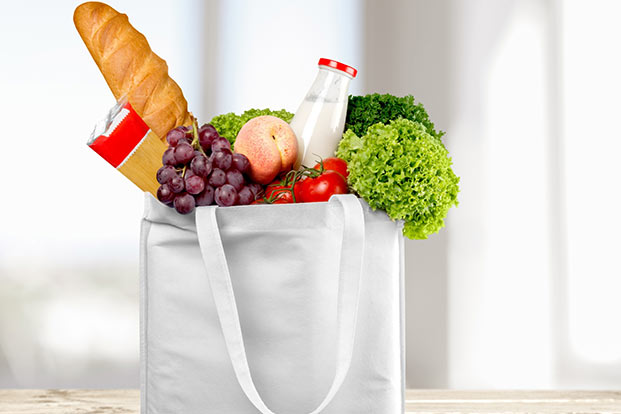You’ve seen them in line at the grocery store. They are the people with the smug looks, the hand-sewn clothing, and their own grocery bags. Oh, no, they say. No bags for me. I brought my own. Their air of virtue is almost too much to endure.
Perhaps you’ve envied them for their thrifty and ecologically minded ways, cursing the darkness that you haven’t been able to plan ahead as they do. But here’s something that may ease your feelings of inadequacy – the bag bearers may actually be bringing a disease-ravaged cloth into their home, one that could potentially spread some serious illnesses.
Yes, the reusable grocery bag, that symbol of man’s triumph over waste and inefficiency, is actually a filthy, dirty mess inside. The Canadian Environment and Plastics Industry undertook a study to look at the bags for levels of yeast, bacteria and mold. They claimed that about 40 percent of the bags studied had mold and yeast that could affect those who have sensitivities, allergies or weakened systems brought about by infections. The study found two-thirds of the bags contained harmful bacteria.
You may be rightfully skeptical about a survey done by the plastics industry, which obviously has a vested interest in the report’s outcome. But there are real-world examples as well. In 2010, Oregon public health officials traced an outbreak of the norovirus in a group of soccer players to a reusable grocery bag.
It seems that packaged cookies team members consumed were left in a bag in a hotel room where a team member was very sick. The resultant aerosol spray of norovirus from the ill girl landed in the bag and festered. Eventually, the researchers on the outbreak narrowed down the potential causes of the disease, focusing on the fact that everyone had consumed the same cookies. That’s when the bag came under scrutiny.
When the bag was tested two weeks later, it was discovered that the norovirus was still there, nestled lovingly inside the virtuous cloth folds. The norovirus is responsible for an estimated 21 million cases of gastrointestinal illnesses a year and some 800 deaths.
Other Studies in the Bag
One of the leading anti-reusable bag studies was a paper created by researchers at the University of Arizona and Loma Linda University. Their study found large amounts of bacteria in reusable grocery bags, including some that contained the dreaded E.coli bug.
The 2011 study, which was widely disseminated, claimed that only 3 percent of shoppers with multi-use bags regularly washed them. The study also found bacteria in 99 percent of bags, with half having coliform bacteria present. Eight percent carried E. coli, which is typically a mark of fecal contamination. One of the research scientists described the bags as “pretty dirty,” likening them to “the bottom of your shoe.”
Locations Ban Disposable Bags
All of this is concerning as more and more cities and states begin to ban convenient plastic bags or charge extra at checkout for their use. Some 69 local laws in California alone ban single-use plastic bags. Most of the money winds up back in the pockets of the stores, who view the new laws as a windfall profit center.
What causes the bags to be disease hotbeds? It’s not any real function of the bag but what we put into them. Items like raw meat, poultry, fish and fresh produce can carry bacteria, parasites and viruses. Packages can leak, and if you don’t have added protections of bagging your vegetables, cross contamination can occur. The bags sit in hot cars or on window sills and other warm places after use, picking up additional germs and festering in their locations until ready to use on the next trip to the store.
Back to Plastic?
Experts say there shouldn’t be a stampede back to plastic bag use, which have their own environmental issues and cause a disposal nightmare for many locations. Just as you take care to wash out a child’s lunchbox, so, too, should you clean grocery bags. Hot water and soap are your friends, but some bags may not be machine washable, so just turn them inside out and hand-wash them in the sink, letting them air dry.
It’s a good idea to have dedicated bags for certain items. A bag for fruits and vegetables, a bag for raw meat, poultry and fish, and still another for dry goods will go a long way toward preventing cross contamination.
Make sure that you use your grocery bags for groceries only. Using them as carryalls for other items brings with it a host of other problems, including bugs and exposure to other worldly ills that the bags may come in contact during their travels.
The University of Arizona/Loma Linda University report that caused a good amount of furor, “Assessment of the Potential for Cross Contamination of Food Products by Reusable Shopping Bags,” has laid out a set of recommendations for consumers using reusable grocery bags. Besides designating separate bags for separate food groups, it recommends that bags not be used for any purpose other than food storage (no gym clothes!) and recommend that the bags not be stored in car trunks, which typically have a higher temperature that promotes bacteria growth.
One chain is also taking proactive steps. The Haggen grocery stores in the Northwest are pushing an antibacterial polypropylene reusable bag that is the first in the world to be treated with AP-360, an antimicrobial product. This controls odor and bacteria, mildew, mold and fungus. Its main ingredient is Chitin, which is derived from crab shells.
Ultimately, reusable bag health rests with the smug user in front of you at the grocery store. Unless they take steps to wash out the bag, they risk that the various germs that accumulate in the bag eventually may reach a critical stage and infect subsequent shopping trips.

Leave a Reply